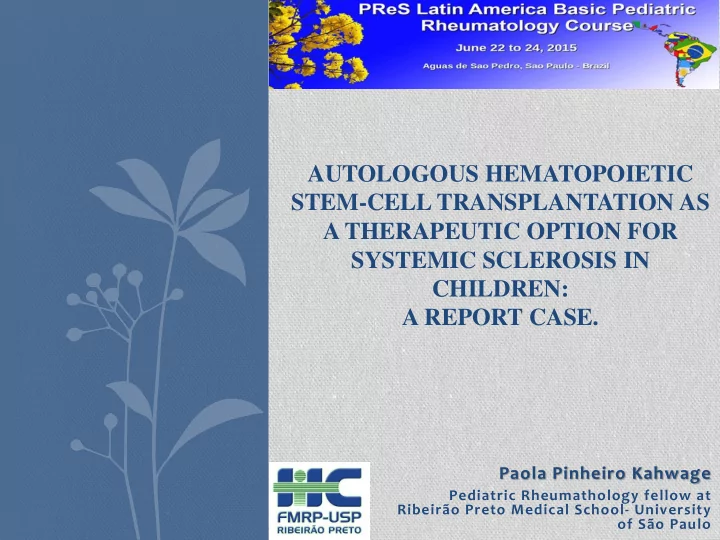

AUTOLOGOUS HEMATOPOIETIC STEM-CELL TRANSPLANTATION AS A THERAPEUTIC OPTION FOR SYSTEMIC SCLEROSIS IN CHILDREN: A REPORT CASE. Paola Pinheiro Kahwage Pediatric Rheumathology fellow at Ribeirão Preto Medical School- University of São Paulo
Case Report • A 3-year-old Brazilian girl presented with skin lesions in limps, trunk and abdomen over a 18-month-period, with a worsening condition after one year having the disease. • In addition, she had febrile episodes, Raynaud's phenomenon, dysphagia, diarrhea and failure to thrive. • Physical examination showed diffuse sclerotic skin plaques over her trunk, abdomen, and limbs (Rodnan score 7). • Lab exams were normal (Hb, CBC, acute phase markers, urine, renal and hepatic function). • Thorax CT scan: normal.
Case Report • Cutaneous biopsy confirmed the hypothesis of scleroderma and videodeglutogram showed decreased esophageal motility. • Treatment was initiated with prednisone (1mg/kg/d), methotrexate 15mg/m2/week and nifedipine. • After 6 months, patient’s condition worsened, with long periods of Raynaud's phenomenon associated with digital ulcers, frequent vomiting and intense abdominal pain episodes with pallor. • Her dysphagia worsened, she was not able to eat and was undernourished (weight and height below P3 for age). • Intestinal radiological evaluation showed decreased motility and evidence of vasculitis.
What would you do? In you opinion, what treatment should be done?
What we did... • The rapid progression of symptoms despite conventional treatment, led us to decide, with family consent, to use HSCT as an option for the disease control. • Prior to infusion of stem cells, the conditioning phase was performed with anti-lymphocyte immunoglobulin, methylprednisolone and cyclophosphamide. • Patient evolution after HSCT was good with apparent complete recovery and absence of previous symptoms. • After being free of any drugs for 3 months (following the standard one year medication protocol) the skin lesions returned but not Raynaud's phenomenon neither gastrointestinal symptoms.
The follow up: Figure 1: Patient ’ s weight for age chart. Figure 2: Patient ’ s height for age chart. Red marking: before hematopoietic stem cell transplantation. Red marking: before hematopoietic stem cell transplantation. Blue marking: after hematopoietic stem cell transplantation . Blue marking: after hematopoietic stem cell transplantation .
Question: • What other treatment would you do? • What would be the best treatment option for the pos- transplantion reativation? • What is you experience with HSCT?
Thank you! • Thank to: • Pediatric Reumathology Unit of Ribeirão Preto Clinical Hospital (Virgínia P. L. Ferriani, Gecilmara S. Pillegi, Luciana M. de Carvalho, Hugo R. Gomes). • Hematopoietic Tranplantation Unit of Ribeirão Preto Clinical Hospital (Maria Carolina O. Rodrigues, Daniela A. de Moraes, Luiz Guilherme D. Junior, Carlos Grecco, Alexandre Valim).
Recommend
More recommend